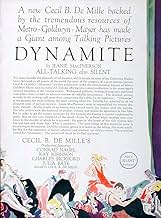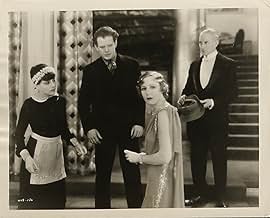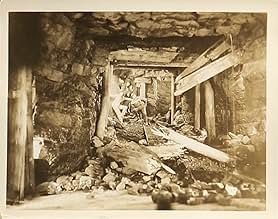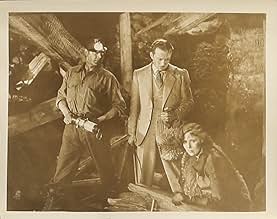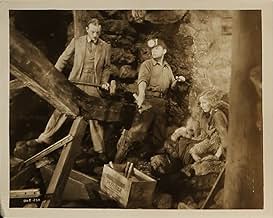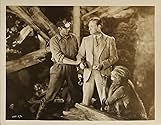Añade un argumento en tu idiomaWealthy Cynthia is in love with not-so-wealthy Roger, who is married to Marcia. The threesome is terribly modern about the situation, and Marcia will gladly divorce Roger if Cynthia agrees t... Leer todoWealthy Cynthia is in love with not-so-wealthy Roger, who is married to Marcia. The threesome is terribly modern about the situation, and Marcia will gladly divorce Roger if Cynthia agrees to a financial settlement. But Cynthia's wealth is in jeopardy because her trust fund will ... Leer todoWealthy Cynthia is in love with not-so-wealthy Roger, who is married to Marcia. The threesome is terribly modern about the situation, and Marcia will gladly divorce Roger if Cynthia agrees to a financial settlement. But Cynthia's wealth is in jeopardy because her trust fund will expire if she is not married by a certain date. To satisfy that condition, Cynthia arrange... Leer todo
- Dirección
- Guión
- Reparto principal
- Nominado para 1 premio Óscar
- 1 premio y 1 nominación en total
- Bobby
- (as Douglas Frazer Scott)
- Good Mixer
- (sin acreditar)
- Mine Foreman
- (sin acreditar)
Reseñas destacadas
DeMille's first sound talking movie under Metro-Goldwyn-Mayer was December 1929's "Dynamite." The director looked towards perfection in his selection of articulate talented actors. Mitchell Leisen, DeMille's assistant as well as his set designer for this movie, screen tested dozens of potential candidates. The list was a who's who in future stars: Dean Jagger, Randolph Scott, Carole Lombard. Two of the three top roles were filled by stage actors appearing in their first movie. The other was a veteran of silent movies.
Actress Kay Johnson earned the lead as socialite Cynthia Crothers, a woman who is passionately in love with married Roger Towne (Conrad Nagel). Cynthia is about to inherit a large inheritance from her late rich grandfather, but has to marry within a month to get it. Since Roger's pending divorce won't come in time, accused murderer Hagon Derk (Charles Bickford), on death row, wants to donate his body to whomever is willing to pay him $10,000 to help his poor sister. Cynthia, seeing his ad, goes to propose a marriage for the money. He accepts. They get married. Minutes before his execution, the real murderer confesses, freeing Derk. That's when things get really interesting for the coal miner Derk, Cynthia and Roger.
DeMille was ready to make movies with the microphone. As his publicist stated, "Cecil DeMille will rehearse the cast of Dynamite until it is letter perfect. This is the first time he has directed dialogue rehearsals since he left Broadway sixteen years ago." The director himself publicly stated he wasn't intimated by the new process: "Dynamite" was my first contribution of any value to sound pictures, retaining the silent techniques, and combining those techniques with sound. I brought those two together, and that perhaps is what 'Dynamite' did for the world." The movie was helped by the strong performances of the three main actors. Kay Johnson attended the American Academy of Dramatic Arts in New York City and appeared in several Broadway plays before getting the call-up from DeMille to appear as Cynthia. During the production, she came down with appendicitis and had to be operated on. Her movie career slowed down in the late 1930s after a robust series of film roles until she and her actor/director husband, John Cromwell, adopted a child and had one of their own, James. Fans of the TV show 'All in the Family' will recognize her son James as Archie's friend Stretch Cunningham. When Johnson divorced John in 1946, she remained in Waterford, CT., where she died at 71.
Charles Bickford, as Hagan Derk, was also a stage actor, playing alongside James Cagney in his first Broadway role in 1925's 'Outside Looking In.' His forceful film presence resembles his real personality as a strong outspoken character. At nine he was charged with attempted murder for shooting a trolly driver after his bus ran over his dog. When filming 'Dynamite," Bickford got in a physical fist fight with one of the assistant directors over his portrayal of Derk, and was always at odds with MGM studio head Louis Mayer. As a freelancer in the mid-1930s, he was mauled by a lion filming 1935's "East of Java," resulting in extensive neck scars. He never quite achieved top-tier star status, but became a popular character actor, earning three Academy Award nominations.
Busy actor Conrad Nagel was already in his 11th talkie. He was one of the few silent film stars to easily make the transition to the movie sound stage, working into the late 1950's after his film debut in 1918.
"Dynamite" was the first DeMille picture to earn an Academy Awards nomination. Leisen, the man who screen tested all the main actors in "Dynamite," was nominated for Best Art Direction.
Of interest especially is the fact that you can recognize the stage training of many of the actors brought to Hollywood with the advent of sound, and how wooden previously silent actors can be when given voice. Also interesting is the characters' flagrant flouting of Prohibition, which still had 4 years left - after all, this was "pre-Code" Hollywood when there wasn't a censor to be found!
Most significant is the sound. The scene which annoys modern viewers is the chaos in the jailhouse wedding scene. However, this is one of the first instances of layered sound: the hammering of the gallows over the prisoner's singing over the wedding vows was a first for a medium that had gone talkie only a year & a half earlier.
So watch it for the details, not the drama
Maybe because of his pompous and pretentious vats of nauseating drivel such as SIGN OF THE CROSS, I instinctively avoid the self-professed great man's movies. But his excellent FOUR FRIGHTENED PEOPLE and MADAM SATAN tempted me to give this ago. So glad I did - it's fantastic, honestly it's a million times better than I was expecting.
There's exceptions of course but I'd normally expect a 1929 talkie to be terrible. Early talkies are generally static and stagey with theatrical actors taking it in turns to enunciate their lines very, very slowly huddled around a hidden microphone. This displays absolutely none of those tell-tale traits. You'll not believe it's De Millie's first talkie! It's so dynamic and as far removed from a studio bound film as you can imagine. Clearly hours and hours of preparation went into this to get it just perfect. Like much more modern films, the camera doesn't simply point at whichever character is speaking. You get cut-always to bystanders showing and hearing their reactions. It's a proper film, not a filmed stage play.
These are people from the 1920s, real people from 1929 so don't expect them to be like us (which is part of the appeal of watching old pictures) but nevertheless the acting in this is natural with characters speaking normally and as in Mamoulian's APPLAUSE, sound is employed virtually another character. An example of that is the portentous beating of the hammer making 'Derk's' scaffold as he's waiting on death row which ominously returns in the dramatic climax.
This is not typical 1929 acting. You're drawn into believing that you're not watching actors but somehow glimpsing into the lives of real people. I've never really rated Charles Bickford before but under a skilful director he's a revelation. A pretty odd sort of guy but one who captivates your attention.
Being as I am, Mr Shallow, my inclination is to watch films with sexy ladies like Joan Blondell or Alice White so I wouldn't normally go out of my way to watch Kay Johnson but like with Charles Bickford she's thoroughly outstanding here. She's a sort of less sexy version of Norma Shearer but in my opinion a more modern and naturalistic actress - dare I say a better actress? I've already enjoyed her performance in MADAM SATAN but now that I've unexpectedly become a fan, I'm going to search out the rest of her work.
A great director, excellent acting and exceptionally high MGM production values make the maddest, silliest story into something quite amazing. Sorry Cecil for doubting you for all these years!
Being made in 1929 we even get the extended roaring of Leo the lion at the start.
The in-between-the-lines context of this movie is also remarkable. Recall that Prohibition of alcoholic beverages had been in effect as a federal mandate for nearly ten years, and that many States had been "dry" with Prohibition for longer than that. But "the glittering society" depicted in this movie was positively soaking in booze. Clearly this movie was written and filmed well before the banking crisis of 1928-29 turned into the bank failures and bank runs of the early 1930s. The pace of the language, the styles, the ways of talking and relating expressed in "Dynamite" show the viewer -- now seventy-five years later -- that the Roaring '20s were very frenetic, indeed.
Prohibition was something for the small towns and rural areas, or so it was said, then. It came into being because activist female leaders made their case that drunken behavior and alcoholism were twin punishments on women and on their children. The majority of bad and abusive drunks in that era, 1880 to 1920, were men, of course. The ones who suffered from their abusive behaviors were their women and their children, or others in their families.
This is a movie which is all about women and men. The lead character, Buddy Derks, is about to be executed for a murder he didn't commit. In a drunken carouse, the young man who committed the murder assaults his drinking buddy with a knife, and this fellow in his turn shoots his friend, fatally wounding him. Before he dies, on the floor of the swank club where they're drinking, he confesses to the murder which Derks has been saddled with. Justice is swift, surprisingly so, and Derks is suddenly released from death row.
He goes then to confront the society 'dame' who paid him $10,000 to marry her, in a jail cell ceremony. The why and wherefore of this marriage of convenience are really extraordinary and that twist makes the movie worth seeing, alone. But suddenly the "dame" has a husband that she really does not want, and that's where the fun begins ....
Bickford is amazing in this movie. He clearly overacts, but it seems somehow so natural for him to do so. Everybody in this moving is either dancing or roaring, it seems, so now we know something about how the Roaring '20s roared !
This "Dynamite" is pure dynamite. TCM has done film buffs a great service by showing it all, and there's every reason to petition them to show it again and again, and not just in the middle of the blooming night !! This movie earned an * 8 * for my vote and I would have given it higher marks if the sound track was made more clear, all the way through. As it stands, it is a unique and appealing cinematic treat.
I recommend it most highly and without mental reservations.
¿Sabías que...?
- CuriosidadesCarole Lombard was replaced during filming, but can still be seen in the released print.
- Citas
Hagon Derk: Ahhhh... bull!
- Créditos adicionalesFilm Title is shown as the word DYNAMITE written on a box of..... dynamite, after being set down by a worker.
- Versiones alternativasMGM also released this as a silent movie.
- ConexionesEdited into Histoire(s) du cinéma: Fatale beauté (1994)
- Banda sonoraHow Am I to Know
(1929) (uncredited)
Music by Jack King
Lyrics by Dorothy Parker
Played on guitar and sung by Russ Columbo in prison
Played on radio and hummed and sung by Kay Johnson
Played on piano as background music and played at the end
Selecciones populares
Detalles
- Duración2 horas 9 minutos
- Color

